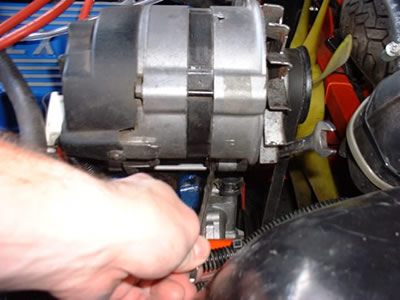
8. Fitting is fairly easy to a standard set of studs, if you want the screw in type the cylinder heads will need to be removed & sent off to a machine shop - so expect a few extra days! Shown here is an old rocker removed - look at the wear at the valve contact end.
Basically, set engine to TDC (Top Dead Centre) by aligning the flywheel notch with the pointer on the front of the engine. You will find it easier to remove all the spark plugs to reduce force required to turn over engine. Make sure no. 1 rockers are closed (number 5 rockers will be in mid-rocking stage - 1 rocker going up, one rocker going down).
9. Once the engine is set, remove each rocker in turn, followed by its pushrod. Place together on a marked out piece of card so you remember where each pushrod goes.
Now comes the difficult part - you will notice that the studs have a tapered top, and each stud will probably vary in height What you will need to do is carefully measure each stud - the best way is with a vernier calliper. Once this is done, on either of no.1 cylinder valves, test fit a new rocker along with its adjuster & locking grub screw, and the pushrod for that valve. As long as the engine hasn't been turned, this cylinder should be in it's firing position so valve to rocker clearance can be set to standard clearance. Now tighten the locking grub screw until hand tight, and measure the amount it protrudes by. Basically, you will need to trim off that measurement to allow grub screw to sit as near as possible to flush with the top of the adjuster nut. As mentioned at the beginning, I found this measurement to be between 5 and 7mm - each stud was at a different height so this explains the variance. Also inspect the clearance between the base of the rocker and the bolt heads on the pushrod guide plate - I found a thinner washer was required, along with some careful grinding of the bolt head to give adequate clearance.
Cutting is best done with a junior hacksaw, after carefully marking each stud with the amount to cut off. You will need to mash up the top of the cylinder head using some thin card and a lot of masking tape to prevent swarf going anywhere. You can help minimise the amount of swarf by regularly applying a light oil to the stud you are cutting - so it keeps shavings on stud & hacksaw blade. Clean area after with a clean rag until all traces of swarf is removed, then taper the very top sharp edge of the stud with a fine file to help new nut find the thread (i.e. so as not to cause a cross thread). Repeat this process with each stud - it takes a while to do so make sure you've got time to finish it in one go. After each stud you can re-try the rocker & pushrod to make sure grub screw is near flush. The reason for this is so that maximum number of grub screw threads are used - a guarantee against unexpected loosening.
Finally, when all is clean & you are happy with clearances, assemble the rockers & pushrods, one at a time, and set the clearances as stated either in your workshop manual, or according to your camshaft manufacturer's data. This figure can vary a lot - so I will not at this stage quote these figures. Needless to say, you can fit no.1 cylinder's rockers if you have not turned the engine, but for each other pair you will need to turn the engine accordingly to make sure each pair is fitted with that cylinder on its compression stroke. See below for the best method to determine this:
Valves Rocking
= No. 5 Cylinder Fit & adjust rockers for
= No. 1 Cylinder
Valves Rocking = No. 3 Cylinder Fit & adjust
rockers for = No. 4 Cylinder
Valves Rocking = No. 6 Cylinder Fit & adjust
rockers for = No. 2 Cylinder
Valves Rocking = No. 1 Cylinder Fit & adjust
rockers for = No. 5 Cylinder
Valves Rocking = No. 4 Cylinder Fit & adjust
rockers for = No. 3 Cylinder
Valves Rocking = No. 2 Cylinder Fit & adjust
rockers for = No. 6 Cylinder
Above figures assume engine is turned over in correct direction - you will need to read up the list if you turn it in reverse direction. Note: Ensure the pushrod is in place both in the cam follower, and in the socket in the rocker before tightening/adjusting!
10. To tighten & carry out the final adjustment of the rockers, the procedure is to progressively tighten the adjuster nut until valve to rocker tip clearance is around 3 thou larger than required setting, then tighten the locking grub screw. The final tightening can now be carried out by tightening the adjuster nut until clearance is reached - it will get very tight as it locks on to stud. Although not as simple as the standard Ford "tight" nut, it is very positive & should last for years as long as the allen key & spanner you use for this are in top condition. Rotate the engine a second time once all rockers have been fitted, and re-check the clearances. You may find you have to adjust one or two slightly - and if so, turn engine a further turn to re-check again. Obviously without knowing what camshaft/head is fitted, it is not possible to know compatitibility of these rockers without modifying the piston tops. I have data which may be helpful if you need more info on this subject - please let me know. Just make sure engine turns freely - if in doubt you may need to remove the cylinder heads!
12. Once engine is re-assembled, start it up & listen carefully to make sure all is well.
Important: Drive car carefully for around 100 miles, then leave to cool overnight, and re-check all the valve clearances. I found the clearances increased in this "run-in" period and required adjusting, as everything settled into place. Once re-adjusted it should be OK to drive as usual.
Page last updated 5 March, 2007

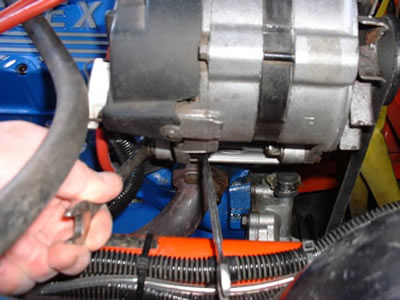
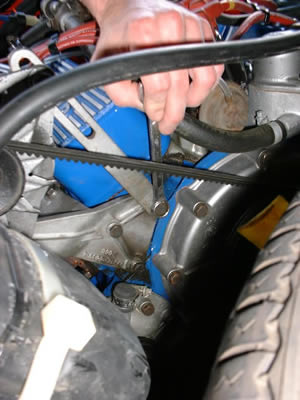
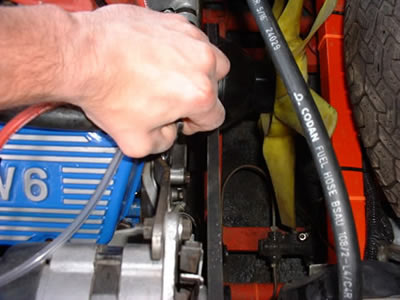
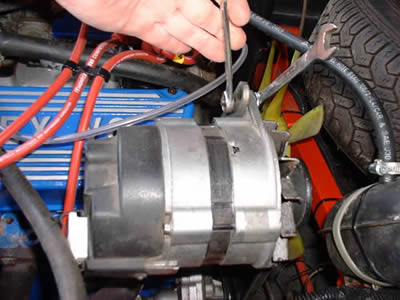
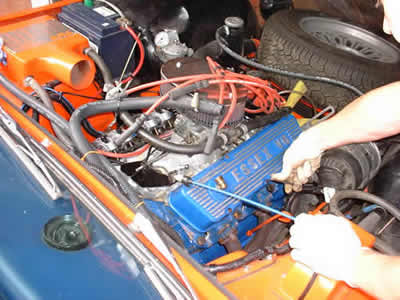
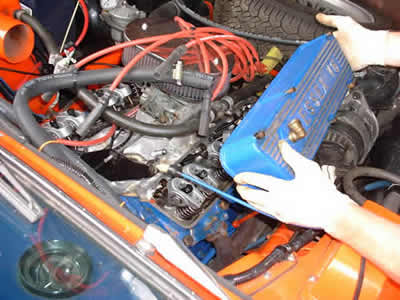
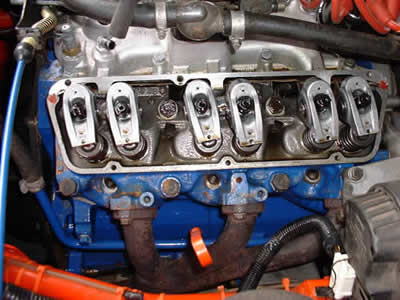
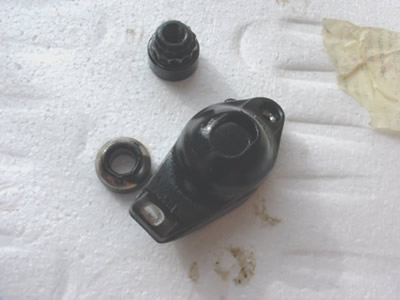
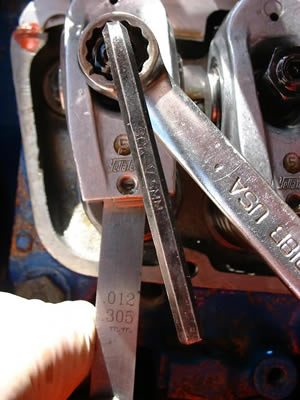
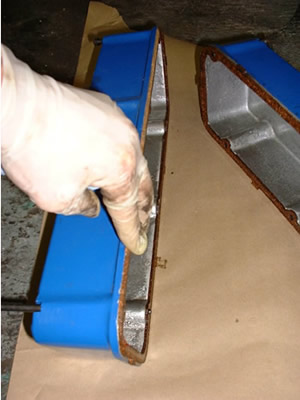
If you see no menu above please click here for home page
Ford
V6 Essex - Fitting Roller Rockers
This
modification will certainly improve the reliability and performance of your
engine, also making it easier to maintain and less prone to wear. The kit in
this article is a Yella Terra "street" kit with a 1.5:1 lift ratio
(I measured the lift and worked out the ratio of the original rockers after
fitting a new cam, and found that they varied between 1.25:1 and 1.38:1 - indicating
they were well & truly worn out/badly matched).
The roller rocker kit consists of 12 rocker assemblies, and a set of general instructions outlining minimum clearances between the culinder head etc. Luckily the V6 Essex requires little modification to allow the fitment, but two tasks are necessary. The first is that you will need to purchase a pair of alloy rocker covers - the original pressed steel items are not high enough to clear the bulkier rockers. Secondly, the stud for each rocker needs to be cut to allow the grub-screw on the new rockers to sit flush with the adjuster head - but this is possible without removing the cylinder head. An essential measurement I took before carrying out this work showed that each stud required between 5 & 7mm removed from the top to allow new rocker's locking grub screw to sit fully home. Another measurement showed that each top was 56mm from the base of rocker cover gasket - hence the need to fit taller allow rocker covers. Lastly, the new rockers fouled the fixing bolt heads of the pushrod guide plates - this meant that thinner lockwashers would be required to create suitable clearance.
Anyway, see below for step by step guide - this will give you a much better
idea of what is involved!